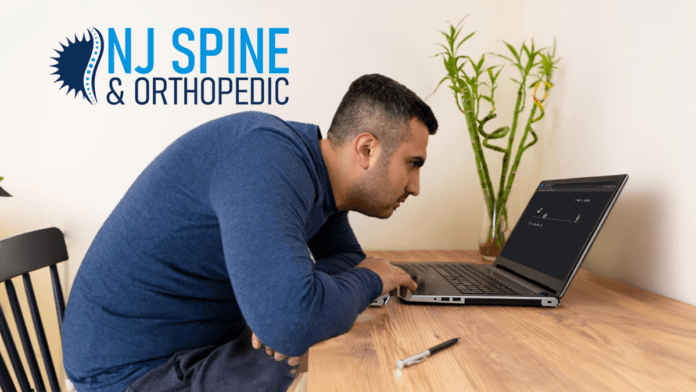The ‘tech neck’ epidemic, a result of prolonged technology use leading to neck and back pain, is growing, with searches for ‘tech neck’ increasing by 245% since 2004. A study by NJ Spine & Orthopedic reveals the most common queries about back and neck pain, including how to sleep with lower back pain, sparks over 10,000 global searches monthly. The study provides expert advice on alleviating pain, including posture corrections, regular breaks and exercises.
- Searches for ‘tech neck’ have increased 245% since 2004, indicating a growing issue of neck and back pain due to technology device use.
- A study by NJ Spine & Orthopedic analysed global searches on neck and back pain, highlighting common questions like “how to sleep with lower back pain”.
- Recommendations to prevent ‘tech neck’ include adjusting device positions, taking breaks, and engaging in neck stretches, while relief for lower back pain involves exercises, posture, and mindful movement.
‘Tech neck’ epidemic: Searches are currently highest on record
Searches for ‘tech neck’ have increased to their highest point on record, increasing 245% since 2004. This phenomenon is a result of the widespread use of technology devices such as smartphones, tablets, and computers, which has led to a surge in neck and back pain issues.
New study reveals the most commonly searched-for questions worldwide about neck and back pain
A recent study conducted by NJ Spine & Orthopedic, an award-winning orthopedic surgeon, analysed the search volume for various queries related to back and neck pain. The study aimed to determine the most searched-for questions from across the globe and provide expert answers to these queries.
The study used SEO tool Ahrefs to analyse the search terms within the past 12 months. The findings shed light on the most common questions people have about neck and back pain, including “how to get rid of neck pain” and “what causes lower back pain”.
‘How to sleep with lower back pain?’ sparks 10,000 monthly global searches worldwide
One of the most searched-for questions worldwide is “how to sleep with lower back pain?” This query receives approximately 10,000 monthly searches globally. Quality of sleep is crucial for those suffering from lower back pain, and finding the right sleeping position can make a significant difference in relieving pain and promoting a peaceful night’s rest.
The study provides expert advice on the best sleeping positions for individuals with lower back pain. Sleeping on your side, especially with a pillow between your knees, is recommended as it helps align the hips and reduce pressure on the lower back. The foetal position can also be beneficial for relieving back pain. On the other hand, sleeping on your stomach can worsen back pain by straining the natural curvature of the spine.
Preventing and treating ‘tech neck’
‘Tech neck’ refers to the pain and discomfort caused by prolonged use of technology devices, leading to poor posture and strain on the neck muscles. The increased usage of smartphones, tablets, and computers, coupled with the growth of remote working, has contributed to the rise of ‘tech neck’ cases.
To prevent and alleviate ‘tech neck’ pain, it is recommended to make some minor changes to daily habits:
- Position devices at eye level to reduce the need for tilting the head downward and bending the neck.
- Download a posture reminder app for regular notifications to maintain proper posture.
- Take frequent breaks from using electronic devices and ensure to stretch neck muscles every half-hour.
- Maintain a distance of 20-30 inches between the screen and the eyes.
- Engage in daily neck stretches and exercises to relieve tension.
Causes of lower back pain in females
Lower back pain can affect individuals regardless of sex, but there are factors that specifically impact women. Menstrual cycles, pregnancy, menopause, and conditions like endometriosis can contribute to lower back pain in females.
Research suggests that women over 30 years old are most at risk of developing chronic pain in the lower back. Premenstrual syndrome (PMS) can also be a frequent source of lower back discomfort in women, with uterine contractions during PMS potentially extending to the lower back. Menopause can lead to lower back pain due to decreased hormone production and lower bone density. Pregnancy causes changes in the center of gravity, weight gain, and hormonal relaxation of ligaments, leading to back pain. Endometriosis, a condition where tissue similar to the uterine lining grows outside the uterus, can also cause chronic lower back pain in females.
Relieving lower back pain
Effective relief for lower back pain includes targeted exercises, proper posture, and mindful movement throughout the day. Maintaining good posture helps distribute the weight of the body evenly, reducing strain on muscles and joints. Low-impact exercises such as yoga, Tai chi, pilates, swimming, and aerobic exercise have been shown to improve posture and alleviate lower back pain in the long term.
Other methods to relieve lower back pain include using heating pads or ice packs for pain and inflammation reduction, practicing relaxation techniques like deep breathing or meditation, using ergonomic supports such as lumbar cushions or pillows, and wearing supportive shoes with cushioned insoles.
Conclusion
The ‘tech neck’ epidemic, characterised by the increased prevalence of neck and back pain due to prolonged use of technology devices, has become a significant concern. Searches for ‘tech neck’ have reached their highest point on record, indicating the growing awareness and need for information on this issue.
The study conducted by NJ Spine & Orthopedic provides valuable insights into the most commonly searched-for questions about neck and back pain. The expert answers provided by the study can help individuals understand the causes of their pain and find effective ways to alleviate it.
By implementing preventive measures, such as maintaining proper posture, taking breaks from electronic devices, and engaging in regular exercises and stretches, individuals can reduce the risk of developing ‘tech neck’ and alleviate neck and back pain.
For more information and expert advice on neck and back pain, you can visit NJ Spine & Orthopedic.
FAQ
Q: What is ‘tech neck’?
A: ‘Tech neck’ refers to the pain and discomfort caused by prolonged use of technology devices, leading to poor posture and strain on the neck muscles.
Q: What is the most commonly searched-for question worldwide about neck and back pain?
A: One of the most searched-for questions worldwide is “how to sleep with lower back pain?”. This query receives approximately 10,000 monthly searches globally.
Q: How can I prevent and alleviate ‘tech neck’ pain?
A: To prevent and alleviate ‘tech neck’ pain, it is recommended to make some minor changes to daily habits, such as positioning devices at eye level, downloading a posture reminder app, taking frequent breaks, maintaining a distance between the screen and eyes, and engaging in daily neck stretches and exercises.
Q: What are the common causes of lower back pain in females?
A: Factors such as menstrual cycles, pregnancy, menopause, and conditions like endometriosis can contribute to lower back pain in females.
Q: How can I relieve lower back pain?
A: Effective relief for lower back pain includes targeted exercises, proper posture, low-impact exercises, using heating pads or ice packs, practicing relaxation techniques, using ergonomic supports, and wearing supportive shoes.













